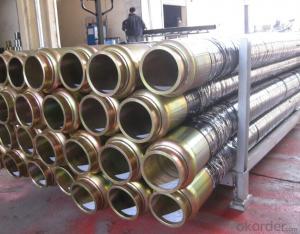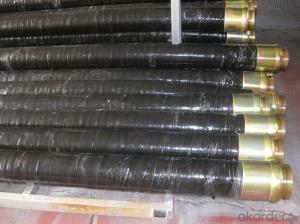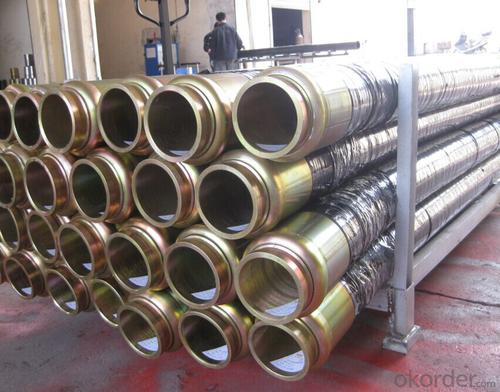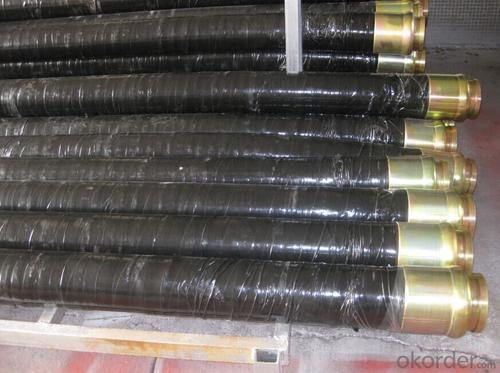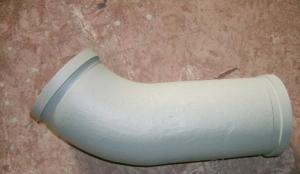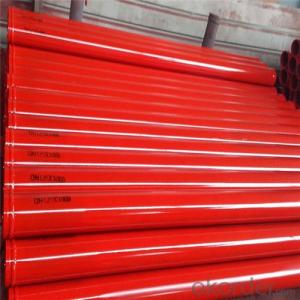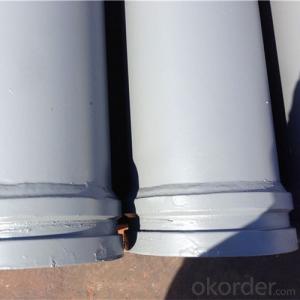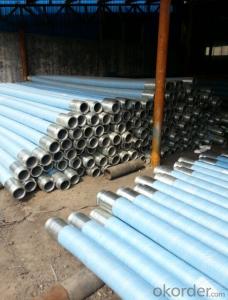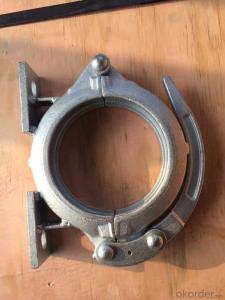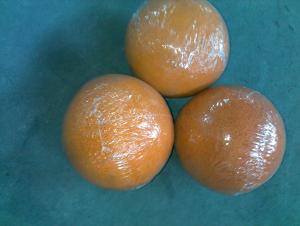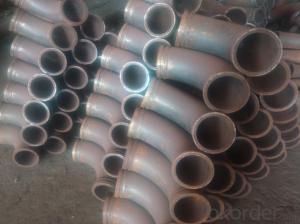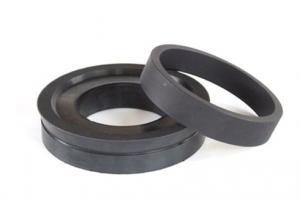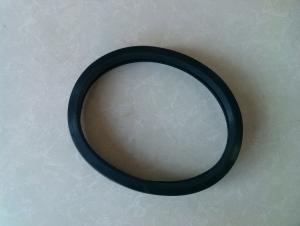4M*DN125(5.5'') RUBBER END HOSE WITH ONE SIDE COUPLINGS WORKING PRESSURE 85 BAR
- Loading Port:
- Shanghai
- Payment Terms:
- TT OR LC
- Min Order Qty:
- 10 pc
- Supply Capability:
- 5000 pc/month
OKorder Service Pledge
OKorder Financial Service
You Might Also Like
Specifications
Putzmeister concrete pump end rubber hose
1. Size: DN150, DN125, DN100, DN80...
2. Length: 1~9m
Concrete pump end rubber hose PM &Schwing
Name | Specifications | Application | Flange diameter | Remarks |
Rubber hose | DN125*3000 | Concrete pump | 148/DN157mm | |
Rubber hose | DN150*3000 | Concrete pump | 148/DN157mm | |
High pressure | DN125*3000 | Concrete pump | 148/DN157mm | Two layers of steel wire |
High pressure | DN125*3000 | Concrete pump | 148/DN157mm | Four layers of steel wire |
High pressure | DN125*4000 | Concrete pump | 148/DN157mm | |
High pressure | DN150*3000 | Concrete pump | 175mm | |
| DN80*5000 | Mortar pump mini conctete pump | 98mm | |
| DN80*6000 | Mortar pump mini conctete pump | 98mm | |
| DN100*5000 | Mortar pump mini conctete pump | 124mm | |
| DN76*6000 | Fine stone concrete pump mini conctete pump |
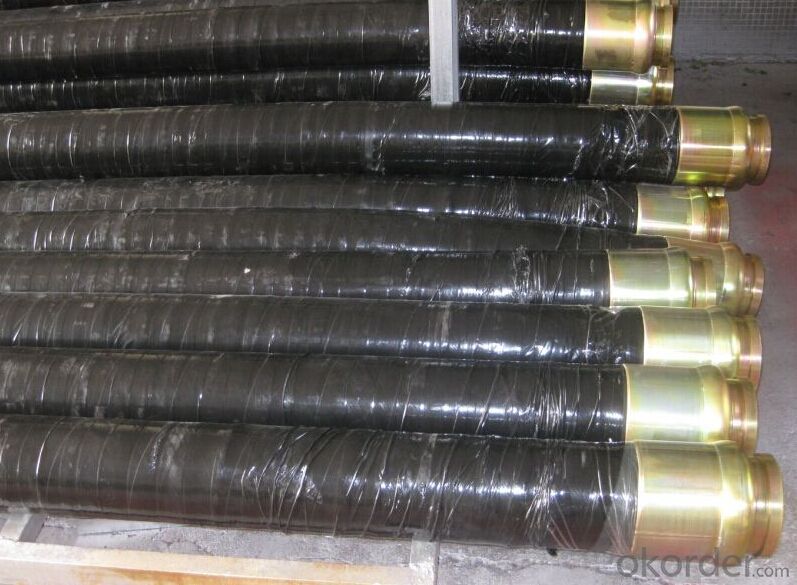
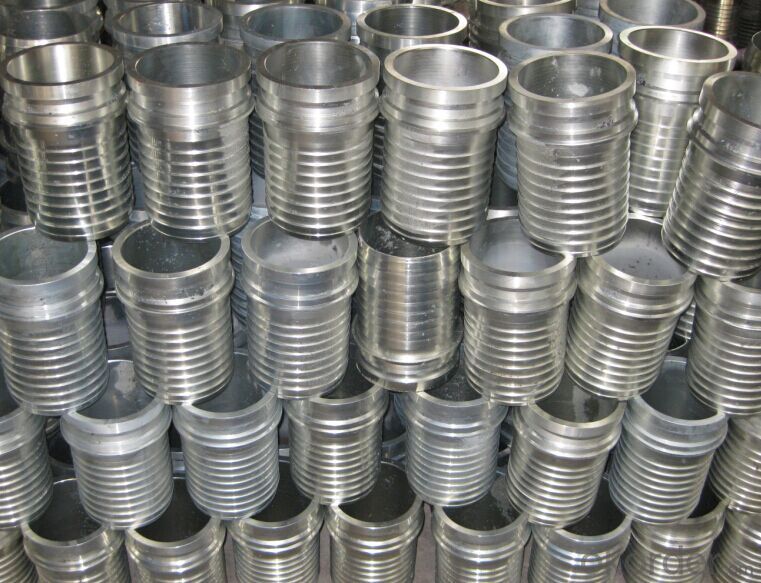
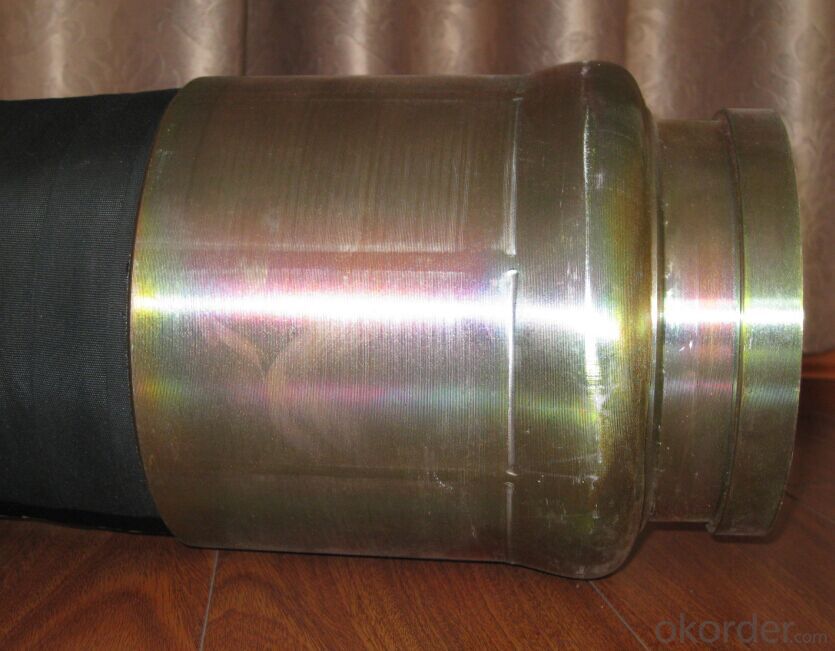
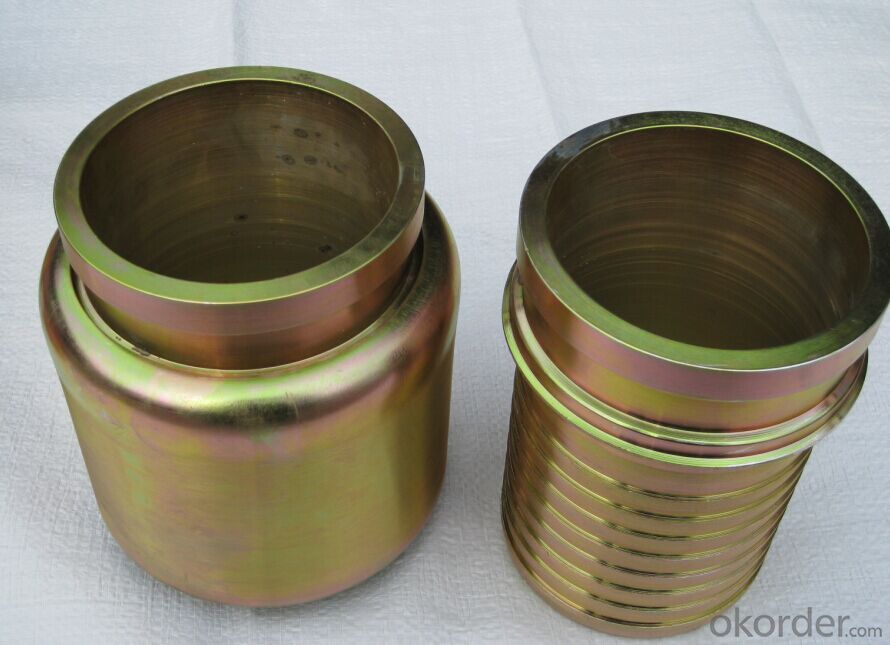
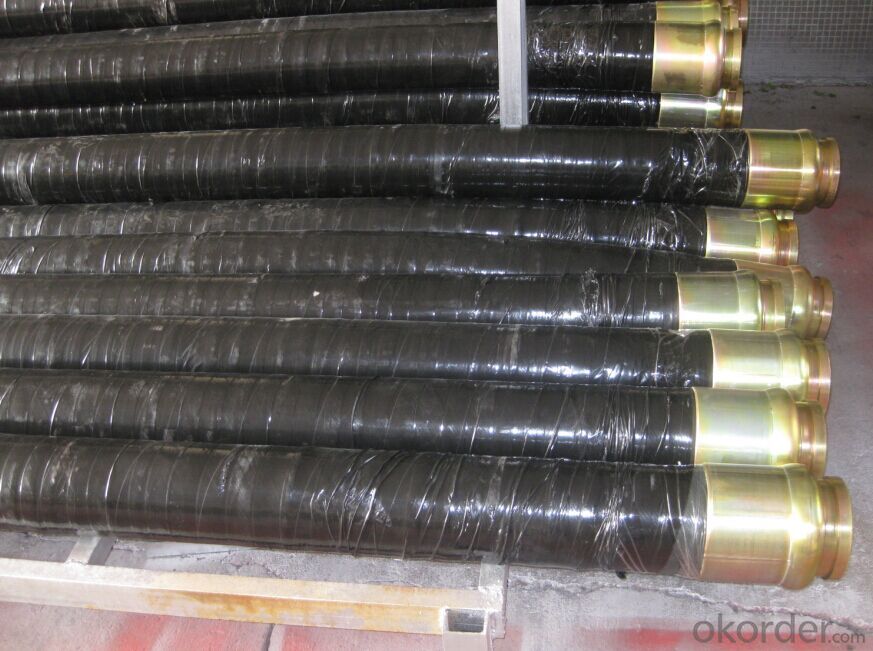
- Q: Are there any safety considerations when using concrete pump spare parts?
- Yes, there are several safety considerations when using concrete pump spare parts. Firstly, it is important to ensure that the spare parts are of high quality and meet the necessary safety standards. Using substandard or faulty spare parts can increase the risk of accidents and malfunctions. Additionally, proper training and knowledge of the equipment and spare parts are crucial to ensure safe operation. Regular inspection and maintenance of the spare parts are also essential to prevent any potential hazards. Lastly, following all safety guidelines and protocols provided by the manufacturer is necessary to minimize the risk of injuries or accidents while using concrete pump spare parts.
- Q: What are the consequences of using substandard concrete pump spare parts?
- There are several consequences to using substandard concrete pump spare parts. Firstly, these parts may not fit properly or be of the same quality as the original ones, which can lead to a decrease in the overall performance and efficiency of the pump. This can result in the pump being unable to deliver the necessary amount of concrete or experiencing frequent breakdowns, causing project delays and higher costs. Secondly, substandard parts may have a shorter lifespan compared to genuine parts. This means that they may wear out or break down sooner, requiring more frequent replacements. This not only increases maintenance costs but also raises the risk of unexpected equipment failures during operation, which can be hazardous for workers and potentially cause accidents. Moreover, the use of substandard parts can compromise the safety of the concrete pump. Genuine parts are designed and manufactured to meet strict quality standards and ensure proper equipment functioning. In contrast, substandard parts may not undergo the same rigorous testing and quality control measures, making them less reliable and more prone to failure. This poses a serious risk to operators and other personnel working near the concrete pump. Additionally, the use of substandard parts can void any warranties or guarantees provided by the manufacturer. Manufacturers typically offer warranties on their products to ensure customer satisfaction and provide support in case of any issues. However, if substandard parts are used, the manufacturer may refuse to honor the warranty, leaving the owner responsible for any necessary repairs or replacements. To summarize, the use of substandard concrete pump spare parts can lead to reduced performance, increased maintenance costs, greater accident risks, and voided warranties. It is crucial to always use genuine parts specifically designed for the concrete pump to ensure optimal performance, longevity, and safety.
- Q: What are the different types of concrete pump hopper cylinders seals?
- There are several different types of concrete pump hopper cylinder seals, including piston seals, rod seals, wiper seals, and buffer seals.
- Q: Are there any environmental considerations in the production of concrete pump spare parts?
- Yes, there are environmental considerations in the production of concrete pump spare parts. Concrete production itself is known to have a significant environmental impact due to the extraction and processing of raw materials, as well as the energy consumption and carbon emissions associated with its production. Therefore, the production of concrete pump spare parts should prioritize eco-friendly manufacturing processes, use recycled materials where possible, and minimize waste generation. Additionally, the selection of suppliers and transportation methods should aim to reduce the carbon footprint of the supply chain.
- Q: Can concrete pump spare parts be retrofitted to older pump models?
- Yes, concrete pump spare parts can be retrofitted to older pump models. However, it is essential to ensure compatibility and proper installation to guarantee optimal performance and safety. Professional advice and support should be sought to ensure correct retrofitting of spare parts to older pump models.
- Q: What are the different types of concrete pump control system sensors?
- The different types of concrete pump control system sensors include pressure sensors, flow sensors, level sensors, temperature sensors, and proximity sensors.
- Q: How to calculate the power of concrete pump motor?
- Of course, the motor power is large, the transmission speed is fast
- Q: How can a faulty pressure gauge affect the concrete pumping process?
- A faulty pressure gauge can significantly impact the concrete pumping process in several ways. Firstly, it may provide inaccurate readings, leading to an incorrect assessment of the pressure within the system. This can result in either excessively high or low pressure being applied during the pumping process, which can lead to various issues. If the faulty pressure gauge displays a higher pressure than the actual value, it may cause over-pressurization of the concrete pump. This can lead to potential damage to the equipment, such as burst hoses or pipes, which can be dangerous for workers nearby. Additionally, excessive pressure can cause the concrete to be pumped too forcefully, potentially leading to the material splattering or leaking from the delivery system, resulting in wastage and an uneven distribution of the concrete. On the other hand, an incorrectly low pressure reading from the faulty gauge can have its own set of problems. Insufficient pressure within the pumping system can result in the concrete not being adequately delivered to the desired location. This can cause delays in the construction process and result in uneven or incomplete concrete placement, affecting the integrity and strength of the structure being built. Moreover, a faulty pressure gauge may also contribute to inaccurate monitoring of the concrete's slump or consistency. The pressure gauge is often used as an indicator of the concrete's flowability, and if the gauge is faulty, it may provide misleading information about the material's workability. This can result in the concrete mix being either too fluid or too stiff, leading to difficulties in pumping and potentially compromising the quality of the finished concrete structure. In conclusion, a faulty pressure gauge can have severe consequences on the concrete pumping process. It can lead to over-pressurization, material wastage, uneven distribution, delays in construction, and compromised concrete quality. Therefore, it is crucial to regularly inspect and maintain pressure gauges to ensure their accuracy and reliability, promoting safe and efficient concrete pumping operations.
- Q: How often should hopper grate handles be inspected or replaced in a concrete pump?
- Regular inspections should be conducted on hopper grate handles in a concrete pump to identify any signs of wear and tear or damage. The frequency of these inspections and the need for replacement may vary depending on the equipment's usage and condition. It is suggested that the hopper grate handles be inspected at least once a month or after every 500 hours of operation, whichever occurs first. During the inspection, it is important to verify that the handles are firmly attached to the hopper grate and to examine them for any cracks, bends, or other structural problems. If any damage is detected, it is recommended to promptly replace the handles to prevent accidents or further harm to the equipment. It is also crucial to adhere to the manufacturer's guidelines and recommendations for the maintenance and replacement of hopper grate handles. By regularly inspecting and replacing the handles as necessary, the safe and efficient operation of the concrete pump can be ensured.
- Q: How can a faulty lubrication system affect the pump's performance?
- The pump's performance can be significantly affected in various ways by a lubrication system that is faulty. First and foremost, the responsibility of a lubrication system is to provide a thin layer of lubricant between the pump's moving parts. By doing so, it reduces friction and wear. However, if the lubrication system is faulty or inadequate, it can result in increased friction between the components. This, in turn, generates excessive heat and accelerates wear and tear. Ultimately, the efficiency and lifespan of the pump are reduced. Secondly, a faulty lubrication system can lead to inadequate lubrication for crucial components like bearings and seals. This inadequacy causes increased friction, heat, and ultimately, premature failure of these components. Consequently, there is increased downtime, costly repairs, and potential damage to other parts of the pump. Furthermore, a faulty lubrication system can also lead to the contamination of the lubricant. Leaks or improper maintenance can allow contaminants such as dirt, debris, or moisture to enter the system. These contaminants cause abrasive damage to the pump's internal components, resulting in reduced efficiency, increased wear, and potential failure. Lastly, the overall performance and energy consumption of the pump can be impacted by a faulty lubrication system. Insufficient lubrication increases the power requirements of the pump as it has to work harder to overcome friction and resistance. This, in turn, leads to higher energy consumption and increased operating costs. In conclusion, a faulty lubrication system severely impacts the pump's performance by causing increased friction, accelerated wear and tear, premature failure of critical components, contamination of the lubricant, and increased energy consumption. Regular maintenance and proper lubrication are crucial to ensure the pump operates optimally and has an extended lifespan.
Send your message to us
4M*DN125(5.5'') RUBBER END HOSE WITH ONE SIDE COUPLINGS WORKING PRESSURE 85 BAR
- Loading Port:
- Shanghai
- Payment Terms:
- TT OR LC
- Min Order Qty:
- 10 pc
- Supply Capability:
- 5000 pc/month
OKorder Service Pledge
OKorder Financial Service
Similar products
Hot products
Hot Searches
Related keywords
